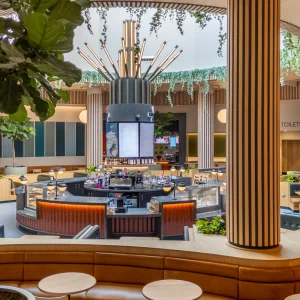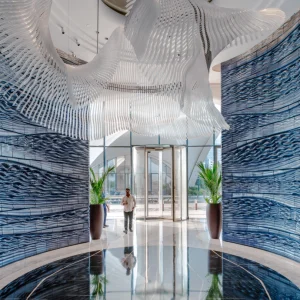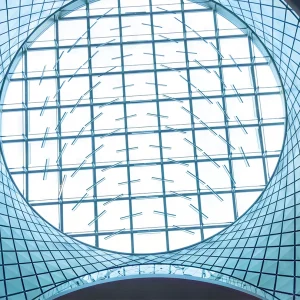
The Art of Space
Pippo Ciorra
Most may not remember this, but the 1996 Venice Architecture Biennale presented the very first attempt to constitute an ‘Italian Pavilion’, curated by Mario Folin, then-director of the University IUAV of Venice. ?Neither a building nor an autonomous space, but rather a contrived intrusion into the mazy geometry of that which is now called the Padiglione centrale ai Giardini, this proto-Italian Pavilion hosted two sections: the first, right at the entrance and curated by Stefano Boeri, recognised the Italian landscape via Gabriele Basilico’s photographic series ‘On the road’. The second, curated by Folin himself, showcased the work of young Italian emerging studios with a crowded sequence of full-scale ‘architectural fragments’.
The two approaches couldn’t have been more diverse. Access to the first section – titled Sezioni del paesaggio italiano – was clear and immediate, guided by an XXL geographic map of Italy and by the simple disposition of Basilico’s black and white photographs. Whilst the sequence of 1:1 fragments – a vague and complex echo of the 1980’s Strada Novissima – was hard to grasp within the awful plan of the Padiglione centrale; its visitors had to struggle physically, to move among the installations as well as to distinguish the work of one studio from another
The confrontation was unequal. The gap between the photographer’s eye, directed out towards world, as opposed to the self-referential gaze of the architects was all too evident. Sezioni del paesaggio italiano documented a country unresolved from North to South: chaotic and spatially anarchical, both in its legal and illegal areas, with unauthorised buildings, still incomplete urban miseries.. So shattered [a country] as to verge on the sublime, at least if looked at thought the eyes of the architect & photographer Basilico’s magical perspective. The sequence of architectural fragments instead gave the idea of a generation already at the risk of being defeated: not too perceptive of what occurred outside their offices or away from the urban and academic centres, and misguidedly confident that good craftsmanship and a well-made detail could alone have saved Italy and her architects from ugliness and isolation.
From that moment onwards, it became clear that photography had a crucial role within Italian spatial culture: the photographers – Basilico first of all, but also Ghirri, Barbieri and many others – were indeed revealing the existence of an other landscape, one persistently ignored by architects and urbanists, despite constituting not less of the 95% of our inhabited space and having great impact on the uninhabited. An informal as well as an ordinary landscape, made of gloomy peripheries – industrial areas that remained unpopulated for 16 hours a day; small strip malls and with immense parking areas; rail tracks brushing against houses and beaches; streets that went nowhere, eventually coming to a stop in front of a house resisting its own demolition. A landscape that in those marvellous pictures was nonetheless starting to claim its own anxious dignity and secret beauty, and that was inevitably doomed to embarrass designers and planners who still considered those places as ‘blank spaces’, merely waiting for a project to articulate them.
Basilico never denied his architectural education and, especially when asked to do so, he always continued to photograph important works, rendering them in memorable black and white images. But in parallel, and with increasing integrity, he has pursued his project of recognition of the contemporary city: with the striking images of a war-torn Beirut – sorely similar, in their composition, to Monti’s Bologna – of Shanghai, Moscow, Rome and Istanbul. Foremost, that peculiar viaggio in Italia [Italian voyage], led with discretion and patience, reminds us of two crucial aspects of his work. The first, as we have just pointed out, is the capability to ‘see’ a landscape not legitimated by any other discipline (besides literature and cinema), thereby awakening the attention of the least distracted part of the Italian urban and architectural culture. The second aspect, even more important, is the slow artistic consecration of the landscape Italian photography, a mission he carried forward with his own ‘travel-companions’.
Basilico’s anonymous architectures and chaotic landscapes have gradually gained autonomy from their documentary project; they have become not just the evidence of a self-organised urban culture but also independent works with their own significance, images of interest to the Italian scholar as well as to the visitor of an exhibition or art collector.
Obviously, Basilico and his work evoke many other things: his generous attention to young people’s work, his willingness to talk about himself and reflect on his work, his ever-ready bag loaded with cameras, etc. But as an architect I can’t be but grateful to him for the great impact that his work had on my work and on my world. Now I remember with melancholic pleasure that when a magazine asked me, about a year ago, to indicate my ‘masters’ through some images, I didn’t quote any architect and chose to publish only pictures taken from Basilico’s Viaggio [voyagel], pictures I am still learning from today.





